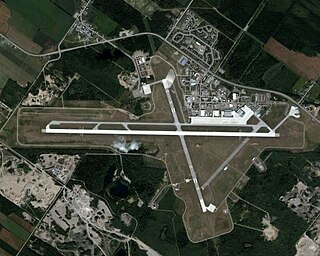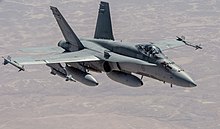The history of the Royal Canadian Air Force begins in 1914, with the formation of the Canadian Aviation Corps (CAC) that was attached to the Canadian Expeditionary Force during the First World War. It consisted of one aircraft that was never called into service. In 1918, a wing of two Canadian squadrons called the Canadian Air Force (CAF) was formed in England and attached to the Royal Air Force, but it also would never see wartime service. Postwar, an air militia also known as the Canadian Air Force was formed in Canada in 1920. In 1924 the CAF was renamed the Royal Canadian Air Force (RCAF) when it was granted the royal title by King George V. The RCAF existed as an independent service until 1968.

The Bell CH-146 Griffon is a multi-role utility helicopter designed by Bell Helicopter Textron as a variant of the Bell 412EP for the Canadian Armed Forces. It is used in a wide variety of roles, including aerial firepower, reconnaissance, search and rescue and aero-mobility tasks. The CH-146 has a crew of three, can carry up to ten troops and has a cruising speed of 220–260 km/h.

438 "City of Montreal" Tactical Helicopter Squadron is a unit of the Royal Canadian Air Force. The squadron operates the Bell CH-146 Griffon tactical helicopter from the Hartland de Montarville Molson Hangar of CFB St. Hubert in Quebec, Canada. Its tasks include armed and unarmed tactical utility transport, training aircrew personnel in basic and advanced aviation tactics, technical training of groundcrew personnel and flight engineers and the periodic maintenance of CH-146 fleet aircraft. They also include as residual capabilities search and rescue, reconnaissance and support to federal, provincial and local law enforcement agencies. A "total force" unit composed of members of the Regular Force, and both full time and part time reservists, the squadron is part of 1 Wing at CFB Kingston Ontario.

Canadian Forces Base Trenton, formerly RCAF Station Trenton, is a Canadian Forces base located within the city of Quinte West, Ontario. It is operated as an air force base by the Royal Canadian Air Force (RCAF) and is the hub for air transport operations in Canada and abroad. Its primary RCAF lodger unit is 8 Wing, commonly referred to as 8 Wing Trenton. CFB Trenton is Canada's largest Air Force base and most southerly air base.

Canadian Forces Base Bagotville, commonly referred to as CFB Bagotville, and also known as Bagotville Airport or Saguenay-Bagotville Airport, is a Canadian Forces base 4.5 nautical miles west of Bagotville in the city of Saguenay. Located in the centre of Quebec, less than 200 km (120 mi) north of Quebec City, CFB Bagotville is operated as an air force base by the Royal Canadian Air Force (RCAF) and is one of two bases in the country using the CF-18 Hornet fighter/interceptor, the other being CFB Cold Lake. Its primary RCAF lodger units are 2 Wing and 3 Wing.

408 Tactical Helicopter Squadron is a unit of 1 Wing, Kingston. It is co-located with 1 Canadian Mechanized Brigade Group at Canadian Forces Base (CFB) Edmonton.

The Boeing CC-137 is a retired transport and tanker aircraft which served with the Canadian Forces from 1970 to 1997. The Boeing 707-347C aircraft provided long range passenger transport for the military, VIP transport for government and air-to-air refueling for fighters such as the CF-116 Freedom Fighter and CF-18 Hornet. It was replaced by the Airbus CC-150 Polaris in the transport role and much later in the tanker role.
Boeing Canada is the Canadian subsidiary of Boeing, with operations in Winnipeg, MB, Richmond, BC, Montreal, QC and Ottawa, ON. Boeing employs more than 1,600 people in Canada. Boeing Aircraft of Canada Limited was formed in 1929 by the American Boeing Airplane Company.

1 Canadian Air Division is the operational-level command and control formation of the Royal Canadian Air Force (RCAF). Prior to 2006 the official abbreviation for the division was 1 CAD. It is commanded by an air force major-general.
Air Transport Command (ATC) was a command of the Canadian Forces created in 1968 upon unification and eliminated in 1975.

Canadian Armed Forces Search and Rescue is the collective name used to refer to search and rescue (SAR) resources and operations within the Canadian Armed Forces (CAF). The Royal Canadian Navy (RCN) and Royal Canadian Air Force (RCAF) are jointly responsible for Canada’s SAR operations.

424 Transport and Rescue Squadron, nicknamed "Tiger Squadron", is a Royal Canadian Air Force strategic transport and search and rescue unit based at Canadian Forces Base (CFB) Trenton in the Canadian province of Ontario. The squadron is the primary provider of search and rescue response for the Trenton Search and Rescue Region, which extends from Quebec City to the Rocky Mountains, and from the Canada–United States border to the North Pole, covering an area of over ten million square kilometres in Central, Western, and Northern Canada.

429 Transport Squadron of the Royal Canadian Air Force is one of four squadrons attached to CFB Trenton in Trenton, Ontario. The squadron was originally formed as a bomber squadron of the Royal Canadian Air Force (RCAF) attached to RAF Bomber Command during the Second World War.

The National Air Force Museum of Canada is an aviation museum dedicated to preserving the history of the Royal Canadian Air Force (RCAF) and is located on the west side of CFB Trenton in Trenton, Ontario.

Operation Mobile was the name given to Canadian Forces activities in the 2011 military intervention in Libya. The United States' counterpart to this was Operation Odyssey Dawn, the French counterpart was Opération Harmattan and the British counterpart was Operation Ellamy. The no-fly zone was proposed during the Libyan Civil War to prevent government forces loyal to Muammar Gaddafi from carrying out air attacks on anti-Gaddafi forces and civilians. The demonstrations in Libya were part of the larger Arab Spring movement that began in the country of Tunisia on 18 December 2010. When demonstrations began in Libya, the government of Muammar Gaddafi responded with systematic attacks by air and ground forces, and repression of the protesters. In a speech, Gaddafi promised to chase down the protesters and cleanse the country "house by house". Several countries prepared to take immediate military action at a conference in Paris on 19 March.

450 Tactical Helicopter Squadron is a Royal Canadian Air Force helicopter squadron. During the Second World War, the numerical designation of 450 was originally given to No. 450 Squadron of the Royal Australian Air Force, which flew under that number from 1941 until 1945 in the Middle East and Italy. Canadian Article XV squadrons during the Second World War had used numbers from 400 to 449; however, due to an administrative error, the "450" designation was used when squadron formed at RCAF Station St. Hubert, Quebec, on March 29, 1968.
The following is a hierarchical outline for the Canadian Armed Forces at the end of the Cold War. It is intended to convey the connections and relationships between units and formations.
This is the structure of the Royal Canadian Air Force, as of November 2020.




























































